
In accordance with modern requirements, imposed on the oil companies to ensure industrial safety
one can noted a number of areas for corrosion activities requiring:
- Increase the level of environmental and engineering controls;
- Increase handling and predictability corrosion processes for oil treatment;
- Rational organization of the monitoring system for corrosive environment including the optimal the use of chemical reagents, provides corrosion protection for at least 90% results in a multiple reduction of accidents;
- Reduction of corrosion wear of equipment leads to lower costs and creates the conditions for turnaround process equipment, by improving manageability and predictability of processes at oil treatment.
- Accumulation and organization of data, provides information to access the equipment at the current
condition.
Corrosion processes at facilities oil evaluated both the corrosivity of process fluids, and the chemical stability of the metal material of the process equipment, that is, its corrosion resistance.
On the oil treatment plants most aggressive to metals vessels and pipelines have a technological medium containing containing water with dissolved oxygen and mineral salts, hydrogen chloride, hydrogen sulfide, sodium hydroxide.
According to leading Western and Russian experts engaged in the study of corrosion deterioration of oil equipment, you can select a number of important factors that may be encountered in the future:
- increase of sulfur compounds;
- not ready equipment to work in the processing of sulfur and heavy oils;
- increased risks that lead to equipment failure influenced corrosion, especially at stops processing plants;
- gain influence corrosive compounds (sulfur, salts, sulfur compounds and organic chlorides).
This assumption is associated with the actual forecasts of the European Commission the EU to increase the production of sulfur and heavy crude oil by 2020.

In the first place in a changing work environment corrosive and unstable operation equipment exposed to corrosive wear of columns, tanks, heat exchangers and piping corps. In these circumstances, in addition to general corrosion serious problem for the integrity of the equipment are local types of corrosion (pitting, intergranular) and stress corrosion cracking, and the prediction and control of existing tools is now extremely complex and ambiguous.
On the process flow of local corrosion and stress corrosion cracking, a significant influenced by a number of specific factors of equipment processing plants.
These specific factors are:
- application of chemical-technological methods of protection equipment, including and the use of inhibitors;
the operation of steaming
- vessels and pipelines before renovations works with the formation of corrosive condensates;
- downtime during repair work or other reasons, if the equipment corrosive deposits together with atmospheric moisture and oxygen.
Solving the problem of corrosion protection equipment of oil production is not possible without a detailed analysis of the features and causes metal corrosion damage during operation, both in routine and different from the routine mode. An important role is the human factor and system methodology to monitor the working environment and corrosion events held during the neutralization of corrosive elements present in the working environment in the mining process and oil. Today, most experts accept the corrosion process as a constant and stable process, which departs from the work on the fixed rate of corrosion over time. Usually the period of determining the corrosion rate of once a month. Unfortunately, in the real situation on the effect of corrosive elements on corrosion carries a different character, associated primarily with changes in the conditions and the composition of the medium on the oil treatment plants. Studies have shown that corrosion can occur due to changes in the conditions of the extraction process, even after several years of steady service, and led to intense pitting. Usually corroded by specialists for corrosion only when the problem became critical and as soon as it is resolved, everything is back to "normal" routine ways of working until the next "unexpected" manifestations of corrosion. In most cases, the organization of anti-corrosion measures are monitoring corrosion using autonomous means of measurements based on the methods of weight loss (coupons), ultrasonic thickness (UST), and analytical control environment. In this case, the information obtained about the corrosion of equipment has the process variables over time, and only the data of average dimensions, which is not enough to determine the causes and conditions of corrosive environment.
Analysis of the effectiveness of anti-corrosion activities at the enterprises of oil production in the Russian Federation is now shown that there is a strong dependence of the efficiency of obtaining data on the corrosive environments and works with the timeframe for subsequent evaluation, analysis and conclusions of the results. Upon receipt of the findings it is important to have a systematic evaluation of the methods applied to risk of possible failures to actually dangerous directions of equipment, and the use of preventive measures and activities that best reduce the likelihood of failure and the risk of damaged items.
Anti - corrosive activities could have the effect only when the increase in the performance of human potential the right decisions. Examples are not the right use of corrosion control measures - such as the wrong choice and the use of inhibitors and their concentration, the material performance, the type of coating process conditions and disorders. Failure, and sometimes a lack of monitoring of corrosion by controlling corrosion situation.
Ineffective use of anti-corrosion measures impact on the ecological impact on the environment, the loss of expensive chemicals, contamination of the process streams of corrosion products, reduced efficiency, productivity and production stop.
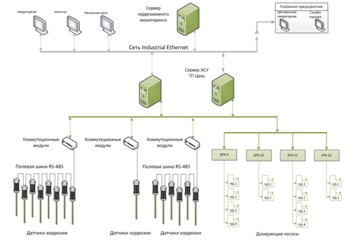
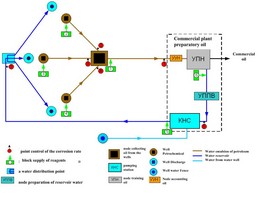
Structural diagram of corrosion monitoring at oil production facilities
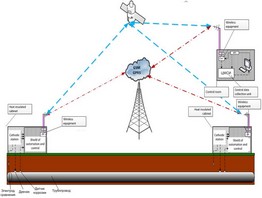
The scheme of a wireless connection the organization of corrosion monitoring
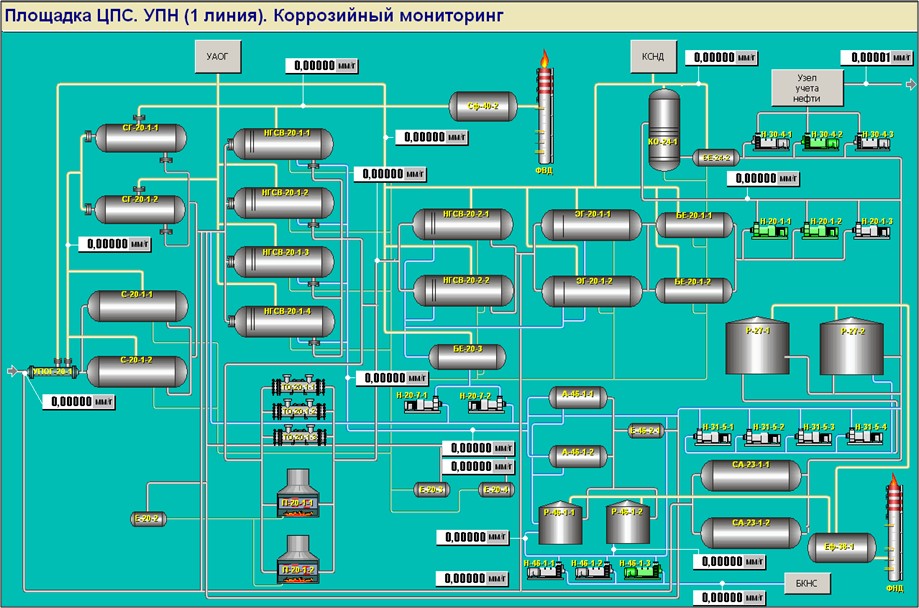
Block scheme of corrosion monitoring "U-X"
LLC "Naryanmarneftegaz"
лмелн scheme of corrosion monitoring "U-X" LLC "Naryanmarneftegaz"
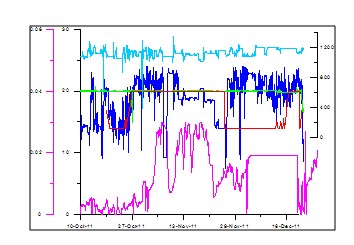
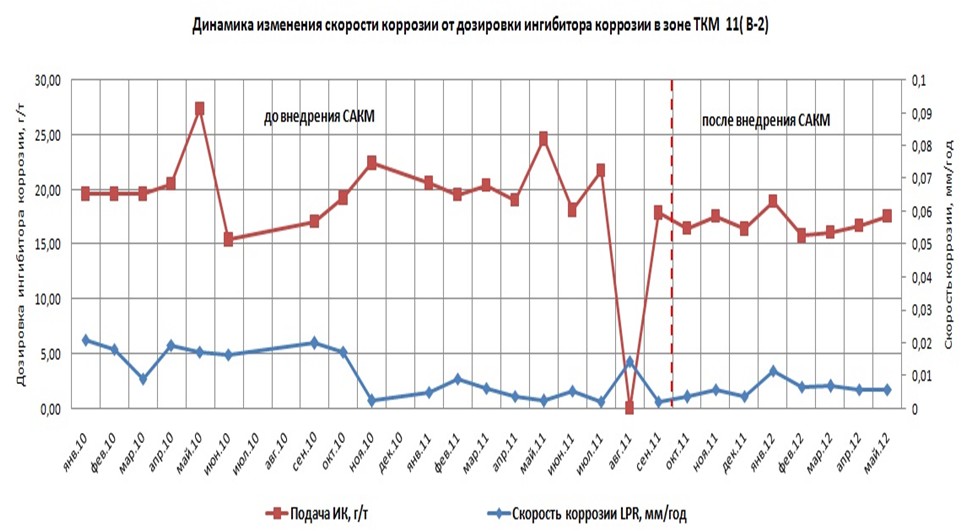
Trends are derived of corrosion monitoring "U-X" LLC "Naryanmarneftegaz'
Comparable trends to implementation and after implementation of corrosion monitoring "U-X" LLC "Naryanmarneftegaz"
"Korsystem" is a leader in Russia's development and implementation of corrosion monitoring systems, real-time. For more than eight years of embedded systems development company "Korsystem" have proven to be effective in protecting equipment from corrosion.
Corrosion Monitoring System developed "Korsystem" provides a measurement parameter signals from sensors monitoring, and then send them through the transmitter to the server Corrosion Monitoring. All incoming information is collected and displayed on the monitor (or printer) as the main parameters affecting the corrosion processes.
Depending on the sensors, automatically, by the feed through automatic regulator inhibitor metering pump or valve. Inhibitor concentration in the work environment, changes in the automatic mode, depending on the sensors control.
Operator is displayed on the monitor process flow diagram, which shows the location of the sensors corrosion and pH, the points of entry of chemicals, control valves, metering pumps and frequency converters.
In real time on the monitor receives indications:
- sensors with corrosion, the corrosion rate in real time;
- with automatic regulators metering pumps (valves) - consumption of reagents fed.
The system has a visual and audible warning steps - anxiety, danger, and the norm in case of deviation from the norm, regardless of the human factor, the works program established acceptable values. In the process, based on a comparison continuously incoming data exclude human error and increases the accuracy of the readings.
Corrosion Monitoring real-time oil production facilities
e-mail: info@korsystem.ru
Protection of equipment and pipelines from corrosion :
- Corrosion Monitoring real time on Oil Refining;
- Audit and assessment of corrosion processes at oil production facilities ;
Scientific and technical developments in the field of industrial safety and protect equipment from corrosion: